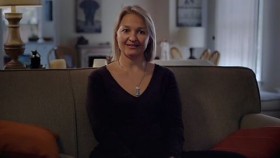På tirsdag den 21. oktober 20:45 sender DR2 Dokumania filmen “Particle Fever”, en videnskabsformidlende dokumentar om verdens største og dyreste forsøg inden for teoretisk og eksperimenterende fysik, bygningen og ibrugtagningen af partikelacceleratoren under CERN, det europæiske forskningscenter for partikelfysik. Eksperimentet skal, hedder det i Dokumanias nyhedsbrev simpelthen ”hjælpe os med at forstå livets oprindelse ved en genskabelse af The Big Bang. 10.000 forskere fra mere end 100 lande samarbejder om verdenshistoriens vildeste videnskabelige eksperiment, og seerne er inviteret til første parket.”
Filmen har valgt over en årrække at følge nogle forskere i gang med dette. Hun her på fotoet hedder Monica Dunford og er fysiker fra Kirchhoff- instituttet på universitetet i Heidelberg. Hun forklarer det sådan til Huffingtonpost.com: “I am an experimental physicist, and with 3,000 of my fellow colleagues, I helped build the ATLAS detector at the Large Hadron Collider, which is the size of a five-story building, encompasses 100 million electronic channels and has more than 1,800 miles of cable. To build this detector, 38 countries had to agree to the micrometer.
My daily work life has involved a mixture of thinking about the big questions (like how can we use this detector to search for dark matter particles), international relations (like managing a group of French, Russians, Georgians, Brazilians, Swedes, Italians and Americans) and large-scale project management (for example, we have 5,000 feet of cable that has to be run by next Tuesday). Zero math…” Hun kan ikke lide matematik og græske bogstaver skrevet med kridt på tavlen på væggen, men hun er ret glad for laboratoriearbejde, for at eksperimentere i praksis. Faget er delt i teoretisk og eksperimentel fysik, og der er brug for begge slags.
“Particle Fever” følger altså seks forskere (også sådan nogle som tænker med kridt i hånden) under opbygningen af den 27 kilometer lange cirkulære tunnel under CERN. Målet med den kæmpemæssige partikelaccelerator er at forsøge at genskabe de forhold, der eksisterede øjeblikket efter The Big Bang og finde Higgs partikel, der potentielt kan forklare oprindelsen til alt stof. Filmen, hedder det videre i Dokumanias anbefaling, ”…prikker til menneskets grundlæggende nysgerrighed om livets oprindelse, og stiller blandt andet spørgsmålet om hvorvidt vi har nået vores grænse for at forstå hvorfor vi eksisterer?”
Det er så rørende, når disse på deres vis bestemt imponerende videnskabsformidlende filmværker, en gruppe, som “Particle Fever så fornemt tilhører”, vil medtage den kunstneriske indsigt. Det lykkes som regel ikke for dem at integrere noget kunstnerisk udsagn i det journalistiske værk, så det ændres fra at være en film-forelæsning til at blive et film-essay. Også i denne film bliver det ved et velment citat fra Beethovens niende symfoni. Naturligvis netop ikke bassens solo med Schillerlinjen om glæden, men det af alle kendte sted, hvor koret kommer for fuld kraft, og naturligvis netop ved filmens vedtagne højdepunkt, hvor eksperimentet lykkes og auditorium og kontrolrum jubler. Og det bliver forsøgt med et kort citat fra Dantes guddommelige komedie i den italienske forsøgsleders festtale. Forsøget at kunstgøre filmen inkluderer uden videre van Goghs stjernehimmel og er tydeligst skuffende i det ret lange citat fra Herzogs “Caves of Forgotten Dreams”, hvor kun billedsiden bruges, netop ikke Herzogs umistelige essay i fortællestemmen.
Todd McCarthy på Hollywoodreporter.com ser venligere og med større forståelse på det her: ”On July 4, 2012, the results are finally obtained, to the joy of those assembled at CERN and in other smaller gatherings around the world. Among the crowd packed into the auditorium is aged British physicist Peter Higgs, for whom the elusive particle was named and who is seen removing his glasses and dabbing his eyes. It’s a well-earned moving climax to the film, as it’s evident that a major frontier has been conquered and new horizons opened up. A clip from Werner Herzog’s cave art documentary Cave of Forgotten Dreams is used to again invoke the link between art and science in the search for coherence and meaning. For the more art-minded, seeing such an articulate and clear-headed elucidation by physicists of what they do results in an invigorating new insight into a vital realm of exploratory endeavor.”
Jeg smiler og tænker: hvor sødt – og foretrækker som art-minded i stedet at lytte til videnskaben, til fysikeren, den almindelige kvinde med almindelig begejstring, som i den sportsverden, hvor hun træner på mountainbike til og fra arbejde på CERN, i løb på landevejen i weekenden og roende støt og sikkert i fireren på søen sammen med venner. Så for mig er den lille stump af filmen, den korte scene med Peter Higgs, som kommer til stede, netop den erfarne filmklipper Walter Murchs udnyttelse af den mindste materialestump, som blot rummer et strejf af den autenticitet, som er afgørende for værkets helhed som noget, jeg tror på og bevæges af.

Peter Higgs
Her har jeg hele spændet af tid og følelse og arbejdsindsats: fra den gamle fysiske teoretiker, som påviste denne universelle byggesten til den unge eksperimenterende fysiker, som i den vældige organisation er med til at påvise higgspartiklens materielle eksistens. Hun kan forklare, så jeg forstår og især begejstres, så jeg følger med, emotionelt accepterende. Uden modstand.
USA 2013, 99 min.
http://www.huffingtonpost.com/monica-dunford/myth-breaking-in-physics_b_5214404.html (interviewet med Monica Dunford)
http://www.hollywoodreporter.com/review/particle-fever-film-review-646439 (anmeldelsen på Hollywoodreporter.com)
http://hub.jhu.edu/2014/03/21/particle-fever-director-levinson (interview med Mark Levinson om produktionshistorien)




